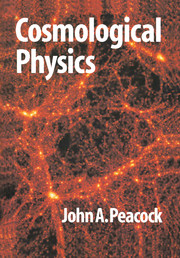Book contents
- Frontmatter
- Contents
- Preface
- Part 1 Gravitation and relativity
- Part 2 Classical cosmology
- Part 3 Basics of quantum fields
- Part 4 The early universe
- Part 5 Observational cosmology
- 12 Matter in the universe
- 13 Galaxies and their evolution
- 14 Active galaxies
- Part 6 Galaxy formation and clustering
- Hints for solution of the problems
- Bibliography and references
- Useful numbers and formulae
- Index
14 - Active galaxies
Published online by Cambridge University Press: 05 June 2012
- Frontmatter
- Contents
- Preface
- Part 1 Gravitation and relativity
- Part 2 Classical cosmology
- Part 3 Basics of quantum fields
- Part 4 The early universe
- Part 5 Observational cosmology
- 12 Matter in the universe
- 13 Galaxies and their evolution
- 14 Active galaxies
- Part 6 Galaxy formation and clustering
- Hints for solution of the problems
- Bibliography and references
- Useful numbers and formulae
- Index
Summary
Advances in observational astronomy during the 1990s have finally allowed direct study of the population of normal galaxies at high redshifts, as discussed in chapter 13. For more than two decades prior to this, the only objects that could be studied out to cosmologically important distances were ‘active’ galaxies such as quasars, where the dominant energy output is not due to stars. This chapter attempts to separate out those aspects of active galaxies that are of especial cosmological interest, although any such division is inevitably blurred. Many of the interesting details of the subject will be omitted: good references for digging deeper into this area are Weedman (1986), Blandford, Netzer & Woltjer (1990), Hughes (1991) and Robinson & Terlevich (1994).
The population of active galaxies
classification Active galaxies come in a variety of species, many of which overlap. The definition of an active galaxy is one where a significant fraction of the energy output in at least some waveband is not contributed by normal stellar populations or interstellar gas; however, all galaxies emit non-thermal radiation at some level, and so classification as active is only a matter of degree. Things are a little more clear cut with AGN (active galactic nuclei), where the non-thermal emission comes mainly from the central few pc of the galaxy.
- Type
- Chapter
- Information
- Cosmological Physics , pp. 419 - 454Publisher: Cambridge University PressPrint publication year: 1998



